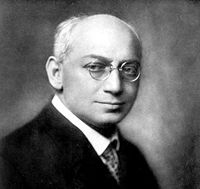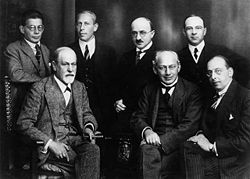Sándor Ferenczi
Sándor Ferenczi | |
|---|---|
 | |
| Born | Sándor Fränkel 7 July 1873 |
| Died | 22 May 1933 (aged 59) |
| Known for | Budapest School of Psychoanalysis, identification with the aggressor, regressus ad uterum |
| Scientific career | |
| Fields | Psychoanalysis |
| Institutions | International Psychoanalytical Association (president) Hungarian Psychoanalytical Society (founder) |
Sándor Ferenczi (7 July 1873 – 22 May 1933) was a Hungarian psychoanalyst, a key theorist of the psychoanalytic school and a close associate of Sigmund Freud.
Biography

| Part of a series of articles on |
| Psychoanalysis |
|---|
 |
Born Sándor Fränkel to Baruch Fränkel and Rosa Eibenschütz, both Polish Jews, he later magyarized his surname to Ferenczi.
As a result of his psychiatric work, he came to believe that his patients' accounts of sexual abuse as children were truthful, having verified those accounts through other patients in the same family. This was a major reason for his eventual disputes with Sigmund Freud.
Prior to this conclusion he was notable as a psychoanalyst for working with the most difficult of patients and for developing a theory of more active intervention than is usual for psychoanalytic practice. During the early 1920s, criticizing Freud's "classical" method of neutral interpretation, Ferenczi collaborated with Otto Rank to create a "here-and-now" psychotherapy that, through Rank's personal influence, led the American Carl Rogers to conceptualize person-centered therapy.[1]
Ferenczi has found some favour in modern times among the followers of Jacques Lacan as well as among relational psychoanalysts in the United States. Relational analysts read Ferenczi as anticipating their own clinical emphasis on mutuality (intimacy), intersubjectivity, and the importance of the analyst's countertransference. Ferenczi's work has strongly influenced theory and praxis of the interpersonal-relational theory of American psychoanalysis, as typified by psychoanalysts at the William Alanson White Institute.
Ferenczi was president of the International Psychoanalytical Association from 1918 to 1919.
Ernest Jones, a biographer of Freud, termed Ferenczi as "mentally ill" at the end of his life, famously ignoring Ferenczi's struggle with pernicious anemia, which killed him in 1933. Though desperately ill with the then-untreatable disease, Ferenczi managed to deliver his most famous paper, "Confusion of Tongues"[2] to the 12th International Psycho-Analytic Congress in Wiesbaden, Germany, on 4 September 1932.[3][4]
Ferenczi's reputation was revived in 2002 by publication of Disappearing and Reviving: Sandor Ferenczi in the History of Psychoanalysis.[5] One of the book's chapters dealt with the nature of the relationship between Freud and Ferenczi.
Ferenczi's main ideas
Activity in psychoanalytic therapy
Contrary to Freud's opinion of therapeutic abstinence, Ferenczi advocated a more active role for the analyst. For example, instead of the relative "passivity" of a listening analyst encouraging the patient to freely associate, Ferenczi used to curtail certain responses, verbal and non-verbal alike, on the part of the analysand so as to allow suppressed thoughts and feelings to emerge. Ferenczi (1994) described in a case study how he used a kind of behavioral activation (uncommon in the psychoanalytic therapy at that time) when he asked an opera singer with performance anxiety to “perform” during a therapy session and in this way to struggle with her fears.[6]
Clinical empathy in psychoanalysis
Ferenczi believed the empathic response during therapy was the basis of clinical interaction. He based his intervention on responding to the subjective experience of the analysand. If the more traditional opinion was that the analyst had the role of a physician, administering a treatment to the patient based upon diagnostic judgment of psychopathology, Ferenczi wanted the analysand to become a co-participant in an encounter created by the therapeutic dyad. This emphasis on empathic reciprocity during the therapeutic encounter was an important contribution to the evolution of psychoanalysis. Ferenczi also believed that self-disclosure of the analyst is an important therapeutic reparative force. The practice of including the therapist's personality in therapy resulted in the development of the idea of mutual encounter: the therapist is allowed to discuss some content from his/her own life and thoughts, as long as it is relevant to the therapy. This is in contrast to the Freudian therapeutic abstinence according to which the therapist should not involve his/her personal life with the therapy, and should remain neutral.[citation needed] The mutual encounter is a precedent for the psychoanalytic theory of two-person psychology.
The "confusion of tongues" theory of trauma
Ferenczi believed that the persistent traumatic effect of chronic overstimulation, deprivation, or empathic failure (a term further elaborated by Heinz Kohut) during childhood is what causes neurotic, character, borderline and psychotic disorders.[citation needed] According to this concept, trauma develops as a result of the sexual seduction of a child by a parent or authority figure. The confusion of tongues occurs when the child pretends to be the spouse of the parent. The pathological adult interprets this infantile and innocent game according to his adult "passion tongue" and then forces the child to conform to his passion tongue. The adult uses a tongue the child does not know, and interprets the child's innocent game (his infantile tongue) according to his disturbed perspective. For example, a father is playing with his little girl. During their common game, she offers him the role of her husband and wants him to sleep with her just as he sleeps with her mother. The pathological father misinterprets this childish offer, and touches his daughter in an inappropriate manner while they are in bed together. Here, the child spoke her innocent childish tongue, and the father interpreted her offer with his passionate adult sexual tongue. The adult also attempts to convince the child that the lust on his part is really the love for which the child yearns. Ferenczi generalized the idea of trauma to emotional neglect, physical maltreatment, and empathic failure. The prominent manifestation of these disturbances would be the sexual abuse.[7]
A Lacanian reading of Ferenczi's 'Confusion of Tongues' was published in 2018 by Miguel Gutiérrez-Peláez.[8] Raluca Soreanu has investigated the metapsychological implications of 'Confusion of Tongues' the Clinical Diary for a theory of psychic splitting.[9]

Regressus ad uterum
In Thalassa: A Theory of Genitality (German: Versuch einer Genitaltheorie, 1924),[10] Ferenczi suggested that the wish to return to the womb (Latin: regressus ad uterum)[11] and the comfort of its amniotic fluids symbolizes a wish to return to the origin of life, the sea.[12][13] This idea of an "uterine and thalassal regression"[14] became a feature of the so-called Budapest School, up to the disciple Michael Balint and his 1937 paper on "Primary [Object-]Love".[15] According to Ferenczi, all forms of human practice, especially sex, were an attempt to reestablish genitalia with the intrauterine experience – a theory which resonated with architect Richard Neutra and may have inspired, or supplemented, Neutra's fascination with uterine suspension.[16] At the same time, Thalassa is embedded in discourses of popular biology, which are reinterpreted by Ferenczi by using psychoanalytic models. Far from simply leaning on Ernst Haeckel, Wilhelm Bölsche, and post-Lamarckism to bolster the psychoanalytic paradigm, Ferenczi defamiliarizes these popular discourses just at a time when they were starting to inform eugenicist projects.[17]
See also
References
- ^ Kramer (1995)
- ^ Ferenczi, Sándor (1949) [1932]. "Confusion of the Tongues Between the Adults and the Child—(The Language of Tenderness and of Passion)". International Journal of Psycho-Analysis. 30 (4): 225–230.
- ^ Sabourin, Pierre (December 17, 2019). "Confusion of Tongues between Adults and the Child". Encyclopedia.com. Farmington Hills, Michigan: Gale. Retrieved January 3, 2020.
- ^ Rachman Wm., Arnold. "Ferenczi's "Confusion of Tongues" Paper: A Turning Point in the Understanding and Treatment of Trauma". Archived from the original on November 20, 2008. Retrieved January 3, 2020.
- ^ Andre E. Haynal (ed.), Disappearing and Reviving: Sandor Ferenczi in the History of Psychoanalysis. London: Karnac Books.
- ^ (Rachman 2007)
- ^ Trauma-related lectures and notes. Ferenczi, Sándor (2014). Infantil-Angriffe! - Über sexuelle Gewalt, Trauma und Dissoziation (in German). Berlin. ISBN 978-3-923-21136-4.
{{cite book}}: CS1 maint: location missing publisher (link) - ^ "Confusion of Tongues: A Return to Sandor Ferenczi".
- ^ Soreanu, Raluca (2018). "The Psychic Life of Fragments: Splitting from Ferenczi to Klein*". The American Journal of Psychoanalysis. 78 (4): 421–444. doi:10.1057/s11231-018-9167-0. ISSN 0002-9548. PMID 30361647. S2CID 255062135.
- ^ Ferenczi, Sándor (1924). Versuch einer Genitaltheorie (in German). Vienna: Internationaler Psychoanalytischer Verlag.
- ^ Hoeller, K., ed. (1973). Review of Existential Psychology & Psychiatry, Volumes 12-14. p. 86.
A psychoanalytical classic that focuses on the return to the womb is Sandor Ferenczi, Thalassa: A Theory of Genitality.
- ^ Sandor Ferenczi on Encyclopædia Britannica.
- ^ Dobrogoszcz, Tomasz (2018). Family and Relationships in Ian McEwan's Fiction. Between Fantasy and Desire. Lanham, Maryland: Lexington Books. p. 28. ISBN 978-1-498-53988-3.
- ^ Ferenczi, Sándor (2018). Thalassa: A Theory of Genitality. Abingdon-on-Thames: Routledge. ISBN 978-0-429-91995-4.
- ^ Akhtar, Salman; O'Neil, Mary Kay, eds. (2011). On Freud's "Beyond the Pleasure Principle". London: Karnac Books. p. 261. ISBN 978-1-855-75785-1.
- ^ Cronan, Todd (2011). ""Danger in the Smallest Dose": Richard Neutra's Design Theory". Design and Culture. 3 (2): 165–191. doi:10.2752/175470811X13002771867806. S2CID 144862490.
- ^ Willner, Jenny (2022). "The Problem of Heredity: Ferenczi's Organology and the Politics of Bioanalysis". Psychoanalysis and History. 24 (2): 205–218. doi:10.3366/pah.2022.0424. ISSN 1460-8235. S2CID 250970240 – via Edinburgh University Press.
Further reading
- Ferenczi's Turn in Psychoanalysis, Peter L. Rudnytsky, New York University Press, 2000, Paperback, 450 pages, ISBN 0-8147-7545-4
- Final Contributions to the Problems & Methods of Psycho-Analysis, Sandor Ferenczi, H. Karnac Books, Limited, Hardback, 1994, ISBN 1-85575-087-2.
- Development of Psychoanalysis (Classics in Psychoanalysis, Monograph 4), Otto Rank and Sandor Ferenczi, International Universities Press, Inc, 1986, Hardback, ISBN 0-8236-1197-3.
- First Contributions to Psycho-Analysis, Sandor Ferenczi, translated by Ernest Jones, H. Karnac Books, Limited, 1994, Hardback, ISBN 1-85575-085-6.
- Sandor Ferenczi: Reconsidering Active Intervention, Martin Stanton, Jason Aronson Publishers, 1991, Hardcover, 1991, ISBN 0-87668-569-6.
- Legacy of Sandor Ferenczi, Edited by Adrienne Harris and Lewis Aron, Analytic Press, 1996, Hardback, ISBN 0-88163-149-3.
- The Legacy of Sandor Ferenczi: From Ghost to Ancestor. Edited by Adrienne Harris and Steven Kuchuck, Routledge, 2015, Paperback, ISBN 1138820121
- Jiménez Avello, José. Para leer a Ferenczi. Madrid: Biblioteca Nueva,1998
- Jiménez Avello, José . L’île des rêves de Sándor Ferenczi. Paris: campagneprmiere/, 2013 (La isla de sueños de Sándor Ferenczi. Madrid: Biblioteca Nueva, 2006)ISBN 978-2-9157-8989-8
- Antonelli, Giorgio, Il Mare di Ferenczi, Di Renzo Editore, Roma, 1996 ISBN 88-86044-44-5
- Keve, Tom (2000). Triad: The Physicists, the Analysts, the Kabbalists. London: Rosenberger & Krausz. ISBN 0-95362190-1.
- Paul Roazen: Elma Laurvik, Ferenczi's Step-Daughter from the pages of PSYCHOMEDIA
- The Correspondence of Sigmund Freud and Sándor Ferenczi, Volume 1, 1908-1914, Harvard University Press
- The Correspondence of Sigmund Freud and Sándor Ferenczi, Volume 2, 1914-1919, Harvard University Press
- The Correspondence of Sigmund Freud and Sándor Ferenczi, Volume 3, 1920-1933, Harvard University Press
- The Clinical Diary of Sándor Ferenczi, by Sándor Ferenczi. Edited by Judith Dupont, translated by Michael Balint and Nicola Zarday Jackson, Harvard University Press. ISBN 9780674135277
- Kramer, Robert (1995). "The Birth of Client-Centered Therapy: Carl Rogers, Otto Rank, and "The Beyond"". Journal of Humanistic Psychology. 35 (4): 54–110. doi:10.1177/00221678950354005. S2CID 145059656.
- Ferenczi, Sándor (1994) [1919]. "XV. Technical Difficulties in the Analysis of a Case of Hysteria1 (Including Observations on Larval Forms cf Onanism and 'Onanistic Equivalents') [pp. 189—198]". Further contributions to the theory and technique of psychoanalysis. Translated by Suttie, Jane Isabel. Compiled by John Rickman. London: Karnac Books. ISBN 1-85575086-4.
- Rachman, Arnold William (2007). "Sandor Ferenczi's contributions to the evolution of psychoanalysis". Psychoanalytic Psychology. 24 (1): 74–96. doi:10.1037/0736-9735.24.1.74.
- Wolman, Beniamin Binem (1977). International Encyclopedia of Psychiatry, Psychology, Psychoanalysis and Neurology. Vol. 5. New York City: Aesculapius Publishers.
- Raluca Soreanu, Jakob Staberg, Jenny Willner: Ferenczi Dialogues: On Trauma and Catastrophe. Leuven University Press 2023. ISBN 9789462703520
External links
- Ferenczi Institute
- Biography at the Sándor Ferenczi Society, Budapest
- At the Frontier of Psychoanalytic Understanding, Academy for the Study of the Psychoanalytic Arts, article written by Judith E. Vida
